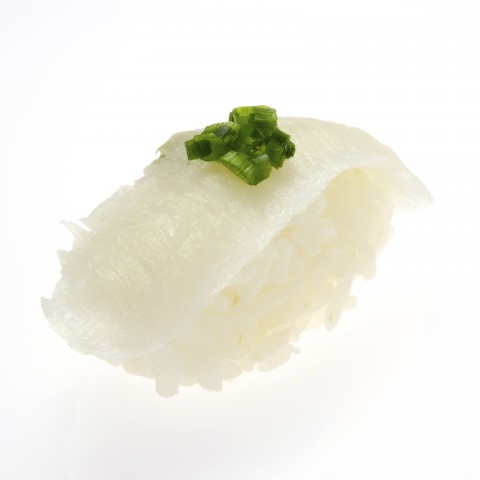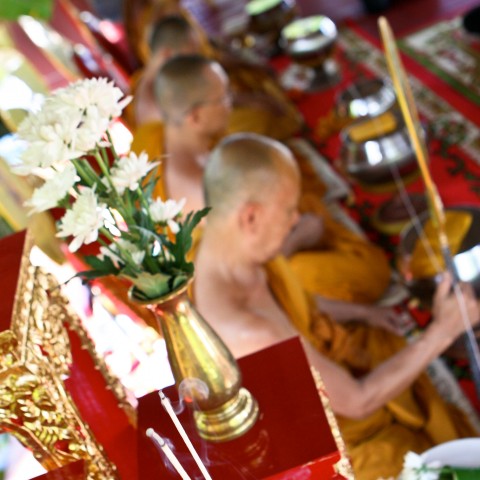
In Thai, there’s a saying, ผิดเป็นครู (phìt-bpen-khruu), which means “learning from your mistakes.”
Still, making mistakes can sometimes be embarrassing, so it’s better if you can avoid them in the first place. Hence, this comprehensive guide on typical Thai language mistakes from ThaiPod101.com.
You’ll learn about mistakes in Thai grammar, vocabulary, word choice, and the appropriate use of Thai phrases. By the end of this article, you should be able to decrease the number of common Thai-English mistakes you make, or avoid them altogether!
 Table of Contents
Table of Contents
- Similar Consonants
- Short and Long Vowel Sounds
- A Note on Tone Marks
- The Correct Tone for คะ (khá) and ค่ะ (khâ)
- False Friends
- ตัวผู้ (dtuua-phûu) is for Male Animals
- Word Order: Nouns and Adjectives
- Politeness Level
- Special Words for Monks
- Being Too Afraid to Speak
- Conclusion
1. Similar Consonants
A frequent mistake in Thai language-learning is that of confusing similar-sounding consonants. In Thai, there are many consonants that have similar sounds, and pronouncing them incorrectly can completely change the meaning of a word. Below are some examples.
1 – ข (kh) and ค (kh)
Despite having the same romanization, these two consonants have different sounds. ข (kh) sounds deeper than ค (kh), and if you use the wrong sound, this could happen:
Thai sentence: เนื้อปลาขาว ๆ น่ากินมาก
Thai pronunciation: núuea-bplaa-khǎao-khǎao-nâa-gin-mâak
Correct pronunciation meaning: “The white fish looks yummy.”
Incorrect pronunciation meaning: “The fishy fish looks yummy.”
Explanation:
- ขาว (khǎao) means “white” in Thai.
- คาว (khaao) means “fishy” in Thai.
You can see that common pronunciation mistakes for Thai-learners like this one can be quite funny.
We recommend that you listen to Thai people speaking often, so that you can learn how to pronounce these consonants correctly.

The white fish looks yummy.
2 – ช (ch) and ฉ (ch)
Another pair of similar-sounding consonants is ช (ch) and ฉ (ch).
Thai sentence: ฉิ่งเป็นเครื่องดนตรีไทย
Thai pronunciation: chìng-bpen-khrûueang-don-dtrii-thai
Correct pronunciation meaning: “The cymbal is a Thai musical instrument.”
Incorrect pronunciation meaning: “Running away is a Thai musical instrument.”
Explanation:
- ฉิ่ง (chìng) means “cymbal” in Thai.
- ชิ่ง (chîng) means “run away” in Thai.
Here’s another tip for avoiding typical Thai mistakes like this one: If there’s romanization, pay attention to the tone of the word. You may notice that, despite both words having the same tone mark, the tones are not the same.
3 – ถ (th) and ท (th)
The last pair of consonants is ถ (th) and ท (th). Here’s what a mistake in Thai might look like if you confuse them:
Thai sentence: คนให้ทั่ว ๆ นะ
Thai pronunciation: khon-hâi-thûua-thûua-ná
Correct pronunciation meaning: “Stir it thoroughly.”
Incorrect pronunciation meaning: “Stir it nut.”
Explanation:
- ทั่ว (thûua) means “thoroughly” in Thai.
- ถั่ว (thùua) means “nut” in Thai.
Hopefully the examples and tips above will help you avoid these common mistakes English-speakers make in Thai!
2. Short and Long Vowel Sounds
Another common pronunciation mistake is to pronounce Thai vowels too short or too long. As there are many pairs of short and long vowels in Thai, it’s important that you pay close attention here. Pronouncing a word too short or too long can change its meaning.
1 – ุ (u) and ู (tuu)
Pronouncing ุ (u) and ู (tuu) incorrectly can lead to this weird situation:
Thai sentence: ดูเด็กคนนั้นสิ น่ารักจัง
Thai pronunciation: duu-dèk-khon-nán-sì nâa-rák-jang
Correct pronunciation meaning: “Look at that child, so cute.”
Incorrect pronunciation meaning: “Scold that child, so cute.”
Explanation:
- ดู (duu) means “look” in Thai.
- ดุ (dù) means “scold” in Thai.

2 – ิ (i) and ี (ii)
ิ (i) and ี (ii) are another vowel sound pair that English-speakers often get confused by. See what happens if you use the wrong sound:
Thai sentence: เขาเป็นช่างตีเหล็ก
Thai pronunciation: khǎo-bpen-châang-dtii-lèk
Correct pronunciation meaning: “He is a blacksmith.”
Incorrect pronunciation meaning: “He is a person who criticizes iron.”
Explanation:
- ตี (dtii) means “hit” in Thai.
- ติ (dtì) means “criticize” in Thai.
3 – ะ (a) and า (aa)
The last example we’ll cover here is the pronunciation of ะ (a) and า (aa).
Thai sentence: วันนี้วันจันทร์
Thai pronunciation: wan-níi-wan-jan
Correct pronunciation meaning: “Today is Monday.”
Incorrect pronunciation meaning: “Today is Dish day.”
Explanation:
- จันทร์ (jan) means “moon,” or if it’s after วัน (wan), it means “Monday” in Thai.
- จาน (jaan) means “dish” in Thai.
3. A Note on Tone Marks
Despite having the same name, you can’t use tone marks to define the tone of words. This is a common mistake in spoken Thai. There are many factors, other than tone marks, that affect the tone of a word. For example, initial consonants and vowel sounds.
Example 1: ขา (khǎa), which means “leg” in Thai, has a rising tone despite having no tone mark.
Example 2: ซ้ำ (sám), which means “repeat,” in Thai, has a high tone despite having a falling tone mark.
Example 3: ฆ่า (khâa), which means “kill” in Thai, has a falling tone despite having a low tone mark.
4. The Correct Tone for คะ (khá) and ค่ะ (khâ)
In Thai, to be polite, females add คะ (khá) and ค่ะ (khà) to the end of sentences. However, many people use these incorrectly. This is the most common mistake in Thai, for both native Thai people and foreigners. Below are examples of how to use คะ (khá) and ค่ะ (khà) correctly.
1 – คะ (khá)
คะ (khá) is used in two conditions:
- After questions
- After sentences that end with นะ (ná)
Example 1:
กระดาษอยู่ที่ไหนคะ
grà-dàat-yùu-thîi-nǎi-khá
“Where is the paper?”
Example 2:
อย่าทำแบบนี้อีกนะคะ
yàa-tham-bàaep-níi-ìik-ná-khá
“Don’t do this again.”
2 – ค่ะ (khâ)
ค่ะ (khâ) is used after affirmative and negative sentences.
Example 1:
ฉันไม่กินเผ็ดค่ะ
chǎn-mâi-gin-phèt-khâ
“I don’t eat spicy food.”
Example 2:
ฉันจะไปทะเลตอนสงกรานต์ค่ะ
chǎn-jà-bpai-thá-lee-dtaawn-sǒng-graan-khâ
“I will go to the sea during Songkran.”

5. False Friends
For those who can speak English, don’t be so happy to see or hear English words in Thai. The meanings may be very different!
1 – Fit
ฟิต (fít) is “too tight” in Thai, while in English, it means “not too tight or too loose.”
- กางเกงตัวนี้ใส่แล้วฟิตมาก
gaang-geeng-dtuua-níi-sài-láaeo-fít-mâak
“These pants are too tight for me.”
2 – Over
โอเวอร์ (oo-vôoe) is “exaggerate” in Thai, while in English, it means “end.”
- เรื่องที่เธอเล่ามันโอเวอร์มาก
rûueang-thîi-thooe-lâo-man-oo-vôoe-mâak
“The story you told is exaggerated.”
6. ตัวผู้ (dtuua-phûu) is for Male Animals
Another Thai word mistake you should know has to do with ตัวผู้ (dtuua-phûu). This word is used for male animals in Thai.
When you start learning the language, you may learn that เมีย (miia) is “wife” in informal Thai and ผัว (phǔua) is “husband.” However, when it comes to animals, Thai people put ตัวเมีย (dtuua-miia) after the animal’s name to specify that the animal is female. You may see this, and think that you should use ตัวผัว (dtuua-phǔua) to specify that the animal is male, but this is incorrect! Instead, you should put ตัวผู้ (dtuua-phûu).
Example:
- สิงโตตัวผู้ (sǐng-dtoo-dtuua-phûu) is “male lion” in Thai.
- สิงโตตัวเมีย (sǐng-dtoo-dtuua-miia) is “female lion” in Thai.

7. Word Order: Nouns and Adjectives
Now, let’s talk about common Thai grammar mistakes that foreigners often make.
In English, adjectives are put in front of nouns; in Thai, it’s the other way around.
Example 1:
ดอกไม้สีขาวมีกลิ่นหอม
dâawk-mái-sǐi-khǎao-mii-glìn-hǎawm
“The white flowers smell nice.”

Example 2:
แม่ชอบผลไม้เปรี้ยว ๆ มากกว่าผลไม้หวาน ๆ
mâae-châawp-phǒn-lá-mái-bprîiao-bprîiao-mâak-gwàa-phǒn-lá-mái-wǎan-wǎan
“Mom likes sour fruit more than sweet fruit.”
8. Politeness Level
Politeness level is the source of many common Thai-English mistakes. In Thai, there are many words that mean the same thing but have different levels of politeness, which you may know already if you’ve studied Thai pronouns. Thus, it’s important to use the right words in the right situations. Using the wrong words can be both inappropriate and funny.
Example 1:
คุณครูกินข้าวเที่ยงรึยังคะ
khun-khruu-gin-khâao-thîiang-rúe-yang-khá
“Have you had lunch yet?” (Talking to a teacher)
Explanation:
The situation here is that a student is talking to a teacher. Thus, the student should ask the teacher this question in a polite manner. The student has already put คะ (khá) after the question, which is good. However, instead of using กิน (gin), it would have been better to use รับประทาน (ráp-bprà-thaan). And instead of using ข้าวเที่ยง (khâao-thîiang), the student should have used อาหารกลางวัน (aa-hǎan-glaang-wan).
Appropriate Thai sentence:
คุณครูรับประทานอาหารกลางวันรึยังคะ
khun-khruu-thaan-aa-hǎan-glaang-wan-rúe-yang-khá
“Have you had lunch yet?” (Talking to a teacher)
Example 2:
เธอมีบุตรกี่คน
thooe-mii-bùt-gìi-khon
“How many sons and daughters do you have?”
Explanation:
Here, two friends are having a conversation. The speaker must be close to the other party, as there’s no ครับ (khráp) or คะ (khá) at the end of the sentence. In this case, using บุตร (bùt), which means “son” or “daughter,” is too polite. Instead, the speaker should have used ลูก (lûuk), which has the same meaning but sounds better.
Appropriate Thai sentence:
เธอมีลูกกี่คน
thooe-mii-lûuk-gìi-khon
“How many sons and daughters do you have?”
9. Special Words for Monks
In Thai language, we have special words for monks which include pronouns and verbs. This is a part of คำราชาศัพท์ (kham-raa-chaa-sàp). Don’t be confused if you hear some words you are not familiar with when the topic involves monks in Thai. Also, it is a good idea to learn basic words related to monks so that you won’t make common Thai mistakes.
Example 1:
พระกำลังสวดมนต์อยู่
phrá-gam-lang-sùuat-mon-yùu
“The monks are praying.”

Explanation:
สวดมนต์ (sùuat-mon) is “pray” in Thai, but it should be used with normal people. For monks, instead of using สวดมนต์ (sùuat-mon), Thai people use ทำวัตร (tham-wát).
Appropriate Thai sentence:
พระกำลังทำวัตรอยู่
phrá-gam-lang-tham-wát-yùu
“The monks are praying.”
Example 2:
พระไม่กินอาหารเย็น
phrá-mâi-gin-aa-hǎan-yen
“The monk didn’t have dinner.”
Explanation:
กิน (gin) is “eat” in Thai, but it should be used with normal people. For monks, instead of using กิน (gin), Thai people use ฉัน (chǎn).
Appropriate Thai sentence:
พระไม่ฉันอาหารเย็น
phrá-mâi-chǎn-aa-hǎan-yen
“The monk didn’t have dinner.”
10. Being Too Afraid to Speak
The biggest mistake in learning Thai is being too afraid to speak with natives.
Don’t be afraid to speak, even if Thai people don’t seem to understand what you’re saying. Thai pronunciation is hard and Thai people know this. Actually, most Thai people find it cute when they hear foreigners trying to speak Thai, and they’ll try their best to understand.
11. Conclusion
After finishing this lesson, we hope you can avoid making these common Thai mistakes. Have you ever made one of these Thai mistakes before? What did you feel? Let us know in the comments!
Do you already know what you’re going to study next in your Thai learning? If you’re not sure, here are some suggestions:
Or you can visit ThaiPod101.com and choose another lesson that interests you.
Happy Thai learning!










